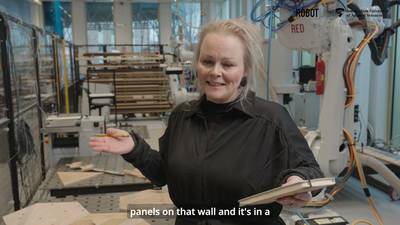Uitwerking van het smart industry ecosysteem voor onderwijs en arbeid. Hierin aandacht voor Smart Industry en Formeel leren, Leven Lang Leren, flexibilisering en Learning by doing.
DOCUMENT

Eindrapportage Smart Industry Hub Noord Nederland
DOCUMENT

How can a smart ‘upcycle wood factory’ (powered by industry 4.0 technologies and principles) help create meaningful and viable applications out of residual wood applicable to the hospitality sector?This video gives the answers.
YOUTUBE

Recycling of plastics plays an important role to reach a climate neutral industry. To come to a sustainable circular use of materials, it is important that recycled plastics can be used for comparable (or ugraded) applications as their original use. QuinLyte innovated a material that can reach this goal. SmartAgain® is a material that is obtained by recycling of high-barrier multilayer films and which maintains its properties after mechanical recycling. It opens the door for many applications, of which the production of a scoliosis brace is a typical example from the medical field. Scoliosis is a sideways curvature of the spine and wearing an orthopedic brace is the common non-invasive treatment to reduce the likelihood of spinal fusion surgery later. The traditional way to make such brace is inaccurate, messy, time- and money-consuming. Because of its nearly unlimited design freedom, 3D FDM-printing is regarded as the ultimate sustainable technique for producing such brace. From a materials point of view, SmartAgain® has the good fit with the mechanical property requirements of scoliosis braces. However, its fast crystallization rate often plays against the FDM-printing process, for example can cause poor layer-layer adhesion. Only when this problem is solved, a reliable brace which is strong, tough, and light weight could be printed via FDM-printing. Zuyd University of Applied Science has, in close collaboration with Maastricht University, built thorough knowledge on tuning crystallization kinetics with the temperature development during printing, resulting in printed products with improved layer-layer adhesion. Because of this knowledge and experience on developing materials for 3D printing, QuinLyte contacted Zuyd to develop a strategy for printing a wearable scoliosis brace of SmartAgain®. In the future a range of other tailor-made products can be envisioned. Thus, the project is in line with the GoChem-themes: raw materials from recycling, 3D printing and upcycling.
De technische en economische levensduur van auto’s verschilt. Een goed onderhouden auto met dieselmotor uit het bouwjaar 2000 kan technisch perfect functioneren. De economische levensduur van diezelfde auto is echter beperkt bij introductie van strenge milieuzones. Bij de introductie en verplichtstelling van geavanceerde rijtaakondersteunende systemen (ADAS) zien we iets soortgelijks. Hoewel de auto technisch gezien goed functioneert kunnen verouderde software, algorithmes en sensoren leiden tot een beperkte levensduur van de gehele auto. Voorbeelden: - Jeep gehackt: verouderde veiligheidsprotocollen in de software en hardware beperkten de economische levensduur. - Actieve Cruise Control: sensoren/radars van verouderde systemen leiden tot beperkte functionaliteit en gebruikersacceptatie. - Tesla: bij bestaande auto’s worden verouderde sensoren uitgeschakeld waardoor functies uitvallen. In 2019 heeft de EU een verplichting opgelegd aan automobielfabrikanten om 20 nieuwe ADAS in te bouwen in nieuw te ontwikkelen auto’s, ongeacht prijsklasse. De mate waarin deze ADAS de economische levensduur van de auto beperkt is echter nog onvoldoende onderzocht. In deze KIEM wordt dit onderzocht en wordt tevens de parallel getrokken met de mobiele telefonie; beide maken gebruik van moderne sensoren en software. We vergelijken ontwerpeisen van telefoons (levensduur van gemiddeld 2,5 jaar) met de eisen aan moderne ADAS met dezelfde sensoren (levensduur tot 20 jaar). De centrale vraag luidt daarom: Wat is de mogelijke impact van veroudering van ADAS op de economische levensduur van voertuigen en welke lessen kunnen we leren uit de onderliggende ontwerpprincipes van ADAS en Smartphones? De vraag wordt beantwoord door (i) literatuuronderzoek naar de veroudering van ADAS (ii) Interviews met ontwerpers van ADAS, leveranciers van retro-fit systemen en ontwerpers van mobiele telefoons en (iii) vergelijkend rij-onderzoek naar het functioneren van ADAS in auto’s van verschillende leeftijd en prijsklassen.